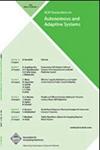Human-Machine Teaming with small Unmanned Aerial Systems in a MAPE-K Environment
IF 2.2
4区 计算机科学
Q3 COMPUTER SCIENCE, ARTIFICIAL INTELLIGENCE
引用次数: 0
Abstract
The Human Machine Teaming (HMT) paradigm focuses on supporting partnerships between humans and autonomous machines. HMT describes requirements for transparency, augmented cognition, and coordination that enable far richer partnerships than those found in typical human-on-the-loop and human-in-the-loop systems. Autonomous, self-adaptive systems in domains such as autonomous driving, robotics, and Cyber-Physical Systems, are often implemented using the MAPE-K feedback loop as the primary reference model. However, while MAPE-K enables fully autonomous behavior, it does not explicitly address the interactions that occur between humans and autonomous machines as intended by HMT. In this paper, we, therefore, present the MAPE-KHMT framework which utilizes runtime models to augment the monitoring, analysis, planning, and execution phases of the MAPE-K loop in order to support HMT despite the different operational cadences of humans and machines. We draw on examples from our own emergency response system of interactive, autonomous, small unmanned aerial systems to illustrate the application of MAPE-KHMT in both a simulated and physical environment, and discuss how the various HMT models are connected and can be integrated into a MAPE-K solution.MAPE-K环境下小型无人机系统的人机协作
人机协作(HMT)范式侧重于支持人类和自主机器之间的伙伴关系。HMT描述了对透明度、增强认知和协调的需求,使伙伴关系比典型的人在循环和人在循环系统中发现的要丰富得多。自动驾驶、机器人和网络物理系统等领域的自主、自适应系统通常使用MAPE-K反馈回路作为主要参考模型来实现。然而,尽管MAPE-K支持完全自主的行为,但它并没有像HMT所期望的那样明确地解决人与自主机器之间发生的交互。因此,在本文中,我们提出了MAPE-KHMT框架,该框架利用运行时模型来增强MAPE-K循环的监控、分析、计划和执行阶段,以便在人类和机器不同的操作节奏下支持HMT。我们以我们自己的交互式、自主、小型无人机系统应急响应系统为例,说明了MAPE-KHMT在模拟环境和物理环境中的应用,并讨论了各种HMT模型如何连接并集成到MAPE-K解决方案中。
本文章由计算机程序翻译,如有差异,请以英文原文为准。
求助全文
约1分钟内获得全文
求助全文
来源期刊

ACM Transactions on Autonomous and Adaptive Systems
工程技术-计算机:理论方法
CiteScore
4.80
自引率
7.40%
发文量
9
审稿时长
>12 weeks
期刊介绍:
TAAS addresses research on autonomous and adaptive systems being undertaken by an increasingly interdisciplinary research community -- and provides a common platform under which this work can be published and disseminated. TAAS encourages contributions aimed at supporting the understanding, development, and control of such systems and of their behaviors.
TAAS addresses research on autonomous and adaptive systems being undertaken by an increasingly interdisciplinary research community - and provides a common platform under which this work can be published and disseminated. TAAS encourages contributions aimed at supporting the understanding, development, and control of such systems and of their behaviors. Contributions are expected to be based on sound and innovative theoretical models, algorithms, engineering and programming techniques, infrastructures and systems, or technological and application experiences.
 求助内容:
求助内容: 应助结果提醒方式:
应助结果提醒方式:


